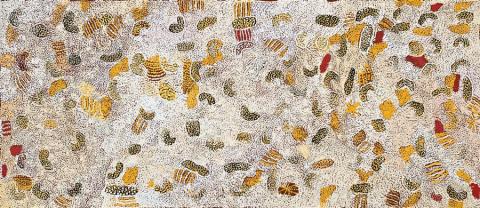PARWALLA, 2006
ELIZABETH NYUMI NUNGURRAYI
synthetic polymer paint on canvas
130.5 x 299.0 cm
inscribed verso: artist's name, size and Warlayirti Artists catalogue number 1000/06
Warlayirti Artists, Balgo Hills
Payla Art, Darwin
Private collection, Darwin
This painting is accompanied by a certificate of authenticity from Warlayirti Artists, Balgo Hills
Elizabeth Nuyumi was born near Jupiter Well on the Canning Stock Route in her mother's country (Nyumi) close to Kiwirrkurra in Western Australia. Nyumi now lives at Kururrungku (Billiluna), an outlying community near Balgo Hills (Wirrimanu). An active teacher and advocate of the importance of traditional culture, Nyumi also advises nurses at health clinics about traditional bush medicines and is married to senior law-man and painter, Palmer Gordon Tjapanangka.
In 1988, Nyumi started painting for Warlayirti Artists, a community run art centre at Balgo Hills and is considered to be a founding figure in the Wirrimanu women's painting movement of the 1980s and 1990s. In this work Nyumi addresses Parwalla, the country of her childhood. Contrasting with the conventional Balgo Hills palette of blistering reds and pinks, Nyumi's creamy pastels interspersed with jewel-like forms speak of an individual aesthetic and sensual engagement with place.
Pawalla depicts the abundance of Nyumi's country, the painting dense with luminous symbols representing bush foods such as Kantjilyi (bush raisin), pura (bush tomato), and minyili (seed). Women are shown as U shapes, with their wana (digging sticks) and coolamons. The many dominating white layers are referred to as kinti-kinti (close-close) which creates a rich texture that references the seeds of spinifex which grow abundantly after the rains.
In 2004, a number of Nyumi's works were included in the Biennale of Sydney, On Reason and Emotion. Within the catalogue which accompanied the Biennale, Hetti Perkins described Nyumi's paintings as expressing 'more than a nostalgic yearning for the past. The arrangement of formal elements in her works articulates the physical connection of desert dwellers to their country. The act of painting Tjukurrpa as an expression of knowledge and creativity reveals a blueprint for physical survival and at the same time regenerates the transcendent energy of the Tjukurrpa. Thus, Nyumi's paintings afford an unequivocal understanding of the symbiotic relationship of Aboriginal people and country.'1
1 Perkins, H., Elizabeth Nyumi Nungurrayi in Carlos, I., (ed) Biennale of Sydney 2004: On Reason and Emotion, Biennale of Sydney, 2004, p. 162
